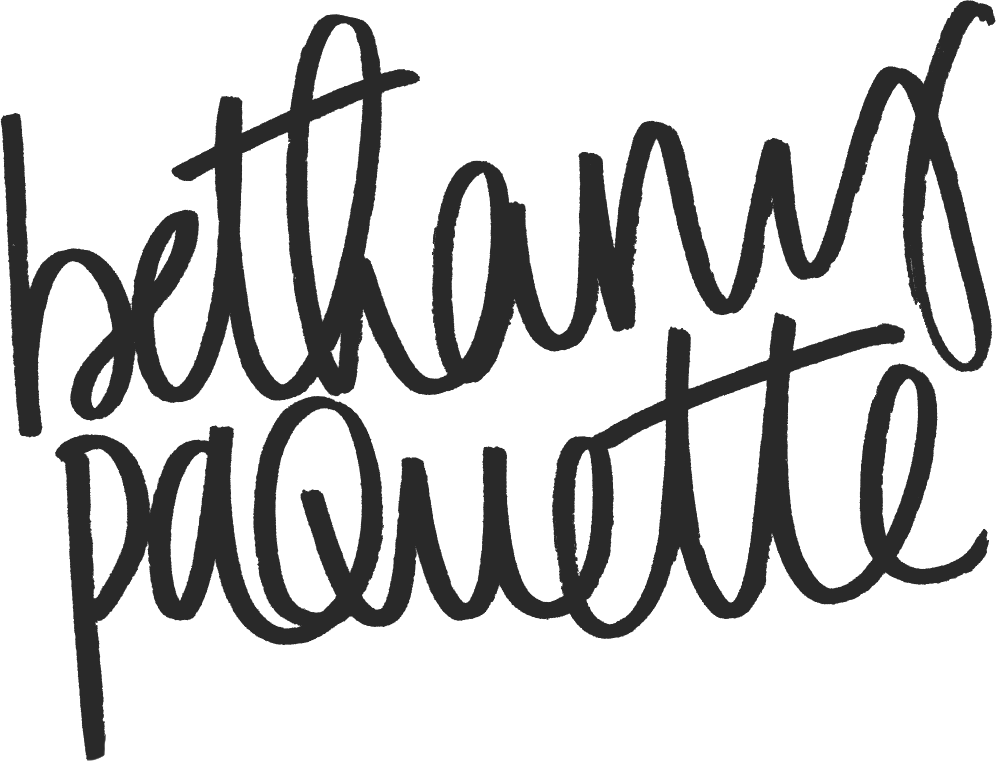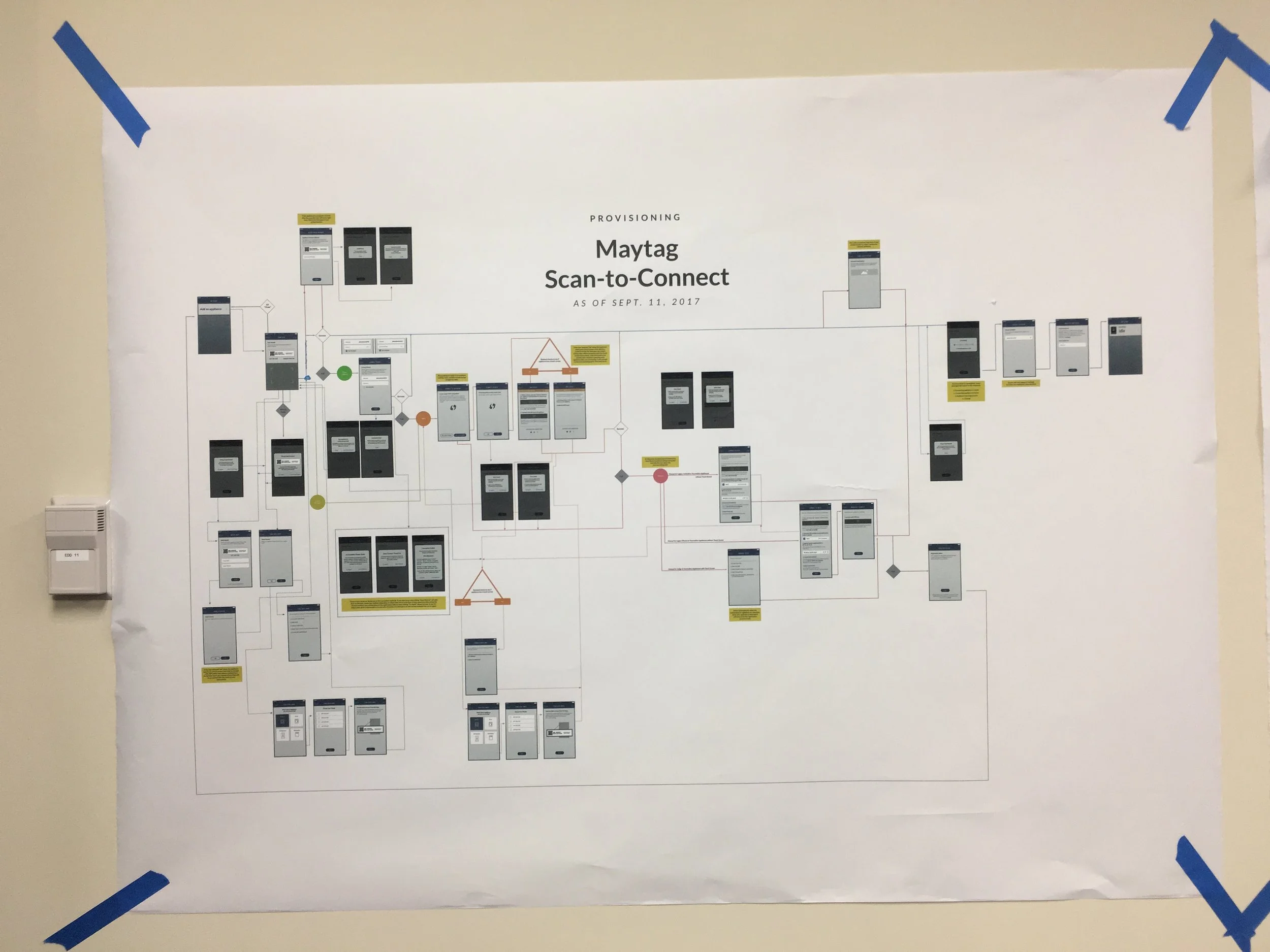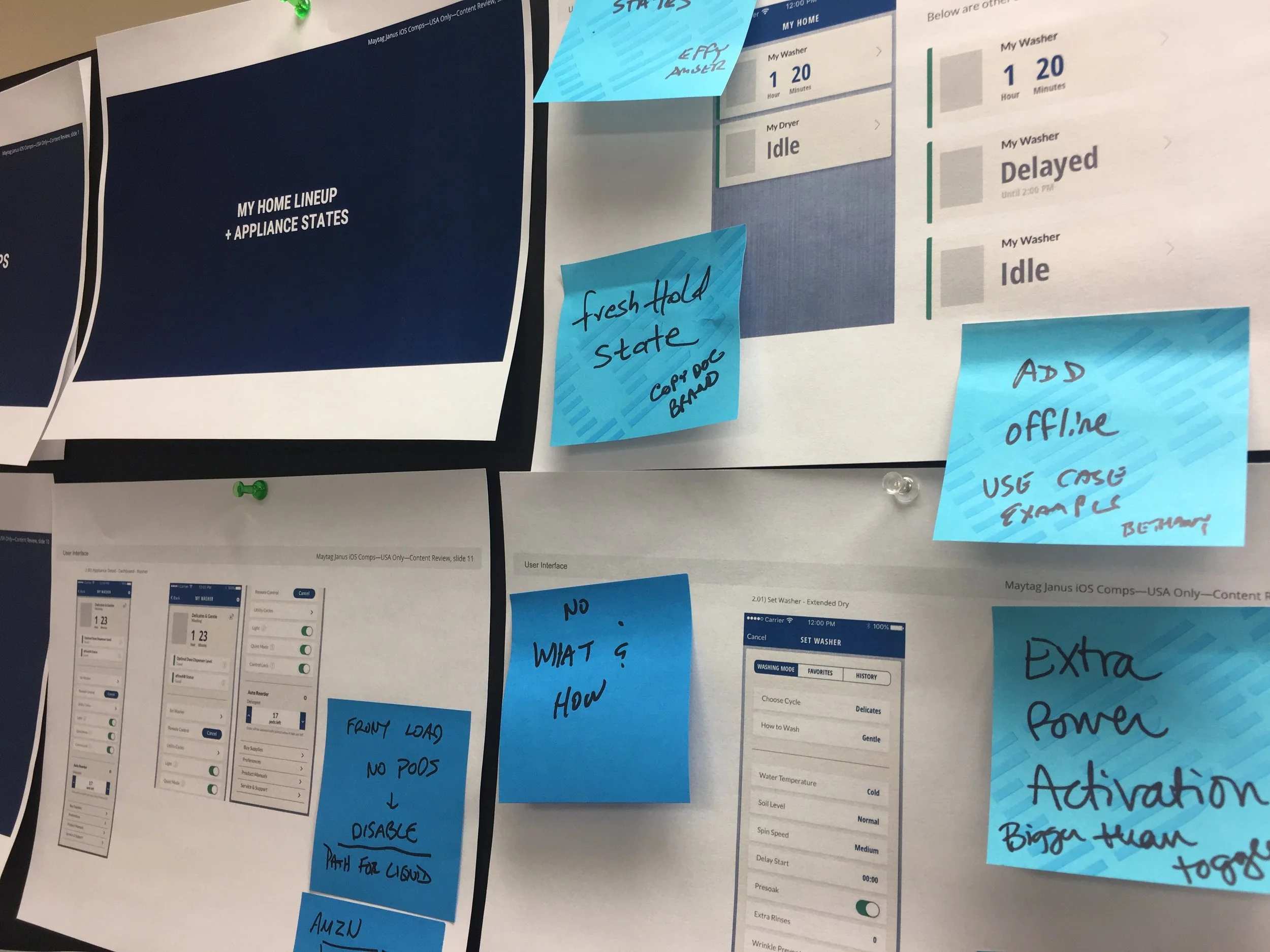The screens you see are updated every few months and are meant to display visual functionality, user experience components, and potentials for additional research. These are explorations to see how best user experience visuals backed by interviews and user research can nestle neatly, but to ultimately ensure that the business, technical, and interactive solution supports the experience requirements.
Projects Shown: UPS International Cargo Shipping, Maytag Connected Laundry Appliances, Caterpillar Financial and Dealer User Experience, Jenn-Air Connected Cooking Appliances App, MyWayy: A Habit Building and Time Management Mobile App, and Miscellaneous Exploration
UPS International Cargo Shipping: User Research and User Experience Design for the world’s leading import/export cargo shipping compliance consultants
The mission: How best do we redesign an international legal trade compliance web application for air and sea cargo that can be used across all borders, all jurisdictions, on all browsers, and decades-old legacy machines in the Global South? This is the best kind of wicked problem.
UPS’ Sandler and Travis is comprised of global trade professionals serving North America, South America, Asia, Africa, Europe and the Middle East—providing import and export services to some of the world’s largest multinational corporations. Their clients are involved in all major industry sectors.
Designing for International Shipping Customs is pertinent to:
Preparation for and representation during government audits and reviews of materials in international cargo shipping
Conflict Minerals Data Solicitation and Reporting Support
An abundance of modern products contain one or more of the four primary conflict minerals—tantalum, tin, tungsten and gold (3TG). When sourced from the Democratic Republic of Congo (DRC) and adjoining countries, procurement of these minerals can be potentially conflicted by violent militias that take control of mines to generate personal profits. After being refined at smelters, these minerals are resold and built into our consumer products. UX Design in conflict material starts with identifying risks, followed by recommending and implementing due diligence procedures that cover solicitation, data gathering and analysis efforts.Import & Export Compliance
Duty Savings Optimization and Duty & Tax Recovery Services
Free Trade Agreement (FTA) qualification, data solicitation and verification
Global Supply Chain Security Programs
Entry/Exit Process Support
My Role: Sole User Experience Researcher and UX Designer leading the client partnership and healthy communication touchpoints
(1 Designer with 17 Developers)
What does my role (and my own standards) expect with such a heavy project? Leading performer with the ability to successfully lead design, manage customer relationships, communicate project health, and manage project shifts to best outcomes. Demonstrating technical expertise, ability to deliver with excellence and provide guidance and expertise to clients and team members.
Auditing legacy applications for irregularities and inconsistencies
Interviewing data entry users to understand the pain points and opportunities
Journey-mapping, priority matrices, local vs. global diagrams, back-end flows, and database flows
Walking lawyers and legal trade compliance experts through a detailed analysis of their web application, then reviewing their vision and intentions with updated UX flows
Redesigning trade compliance web application that can be used on legacy machines dating back to Windows XP, due to limited resources
Applying user-evoked machine learning
Identify and hone in on skill set of the team—both technical and consulting—and provide opportunities for professional development
How do we redesign legacy software to manage all of this? How might we reduce the risks of international trade while shortening cycle times and lowering overall costs?
(Click image to view larger)
This is the old system I was tasked with redesigning—issues with hierarchy, accessibility, flow, and error paths.
(Click image to view larger)
This is the new system I was working on with developers (a little bit more high-fidelity wireframe).
1. After finding opportunities to solve issues with Global Trade Compliance management, we road-mapped our minimum viable product (MVP) features—and what is MVP for each feature. The lean startup MVP method helps the team to release a product that can be continually improved as we validate (or invalidate) assumptions, learn what our users actually want, and build future iterations of our management service that better serve our trade brokers. The goal is to provide immediate value, quickly, while minimizing development costs.
In this stage, we asked ourselves:
- What needs to be done?
- Whether or not it has been done?
2. Breaking the roadmap down into an action priority matrix: Effort versus Impact. When we use the matrix to choose activities intelligently, we can spend more of our time on the high-value activities that keep us moving forward.
In this stage, we asked ourselves:
- How far along is this?
- How much effort will it take/has it taken so far?
3. Lastly, we assigned our tasks to months in Q4 and eliminated low-impact activities.
In this stage, we asked ourselves:
- When is it due?
- Who is responsible for doing it?
- Who has been looped in to receive automatic updates or watch over progress?
Grabbing quick opportunities for level-setting lawyer-speak to design-speak nomenclature.
Not everyone has time for redoing a journey map for a small sector of international trade compliance. Sometimes it just takes those little moments to hash everything out.These are moments that matter in initiative planning with large, worldwide software ecosystems. Unpacking end-to-end experiences in just one or two screens is a responsibility of supporting enterprise strategy as awhile and strategies across silos.
How do you make data tables that are functional, reliable, and convenient across all browsers, all nations, and all machines across the world? Grab cross-discipline experts in a room, and facilitate the workshop through consistent hierarchy of needs. This makes clear lanes for priority and skill sectors.
The The UX Hierarchy of Needs To Be Fixed, grabbed from David Burke at the 2011 IA Summit. I use this to find patterns in UX defects and prioritization. This also creates common language across design and development teams.
Customer experiences are increasingly complicated—with multiple channels, touchpoints, contexts, and moving parts—all delivered by fragmented organizations. How can you bring researchable ideas to life in the face of complexity? Read up while you rest outside of office hours.
What do I do to create opportunities to hone my skills beyond building relationships and identifying key moments in UX research and design? A lot of reading.
Amway AmChef (Connected ThermoCooker) Usability/Validation Testing
Facilitating critical takeaways from User Acceptance Testing and showcasing a “gallery”. The value of uncovering relevant and observable problems comes with discovering the blindspots. In order to isolate opportunities for solutions, I observed not only what happened in UAT, but also why it happened. This validates/invalidates team assumptions about users.
Key Responsibilities
My Role: User Experience Researcher and UX Designer
Consulted user experience designers as a thought leader to expand and sharpen their UX craft in IoT
Served as a thought leader/Influencer both internally and externally
Served as a Technical Subject Matter Expert within at least two domains
Provided leadership and guidance to other consultants within the practice
Guided others to find their strengths and opportunities for improvement through meaningful feedback and coaching. Identifying intentional curiosity to grow teams.
Key Competencies
Attention to data and ambiguity: Made high quality decisions in a timely manner, usually with less data and analysis than might be desired. Balanced facts with intuition and experience, sought counsel from other when needed, and demonstrated a bias for action.
Constant Communication and Transparency: Took a multi-faceted approach to problem-solving and creation of novel solutions to problems. Championed learning and sharing across OST and Amway. Used my abilities to take viewpoints that are broader than my immediate practice or team and encompassing external factors.
Evidence- and data-based research: Interacted with others to present information in an engaging and understandable manner. Provided communication that is clear and concise, demonstrating strong listening skills, and consistency in verbal and non-verbal messages.
Developmental leadership: Enthusiastically encouraged others to reach their highest level of effectiveness as Individuals and as teams. Sought out development opportunities for self and others modeling personal development and willingness to take risks to develop myself. Guided others to find their strengths and opportunities for improvement through meaningful feedback and coaching.
Key Screens I Designed for the Machine
Initial Stages of Amchef’s IoT Progress
More Talking Points!
We crafted the AmChef buyer personas to ensure they covered both the Primary and Secondary target markets.
Each persona is motivated to use the AmChef for different reasons, but they all fit into one or more of the three recognized themes (learn, plan, community).
AmChef is inherently designed to teach users how to cook. The step-by-step nature of the recipes serve to not only show how to use the AmChef, but also introduce different cooking styles and choices.
User Flows helped us analyze how the user would navigate through the app and how that navigation would affect the AmChef. This also helped us address technical considerations and recognize where there were gaps or uncertainties.
The proposed architectures for both the app and the AmChef should be validated early by talking to users.
IoT has strong legal considerations to keep in mind. Designing for a physical IoT product not only means physical patents, but user interface patents as well.
Usability and Validation Testing
Approach each observation session with an open mind. Guiding research efforts from writing research objectives, plans, and scripts, to reports.
Guiding research and teaching juniors:
If you feel like there’s something to talk about that’s worth noting, make the time for it. Don’t skim over important moments, and don’t feel like you have to stick to the script.
Let the participants be. Don’t interrupt or talk over them. If you do, they’ll avoid sharing additional things with you, and you might miss key insights.
Pitch your level of know-how to match the participants. Don’t make them feel like you’re more knowledgeable (this goes into bod language, like standing above them).
Avoid DRIP: data-rich, information poor results.
Collect Data and Pay Attention.
As we focused on actions and elements related to our goals, when we observed a study participant, I encouraged my team to look for the following occurrences:
Routines
Interactions
Interruptions
Shortcuts/workarounds
Contexts
Habits
Rituals
Jargon
Annoyances
Transitions
Artifacts
Practice!
A short yet critical step. We used our great intern. This will help with setting expectations, getting used to paying attention to important things, note-taking, taking photos, invading personal space, not bumping into one another, and other small logistics stuff.
Testing it out
Since natural tasks have a lot of variability, I encouraged our moderator to gather open ended-questions on top of the script I had already written. This is often the most important part of the testing session, simply because you can’t predict in advance exactly what your users will do.
So, tell me what you’re looking at.
What’s going on through your mind right now?
What do you want to do from here?
What kind of info are you looking for on this screen?
What stands out to you most?
What were you expecting when you first came to this screen?
When did you decide to leave that screen?
What brought you to this screen?
Is there any more info on this screen you’d like to see included that you don’t already see here?
Results from another study in Closed Card Sorting. Remote and unmoderated, quantitative.
A part of designing and owning the solution is setting technical direction, and I do that through facilitating UAT feedback sessions to hone in on opportunities for solutions later.
The ultimate test participants? Professional chefs. We brought in Susie Heller, a published chef with over 35 years experience in guided cooking, and author of the best-seller, The French Laundry Cookbook.























